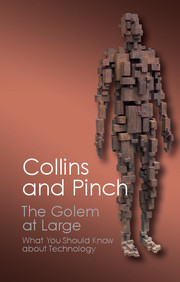Book contents
- Frontmatter
- Dedication
- Contents
- Preface and acknowledgements
- Introduction: the technological golem
- 1 A clean kill?: the role of Patriot in the Gulf War
- 2 The naked launch: assigning blame for the Challenger explosion
- 3 Crash!: nuclear fuel flasks and anti-misting kerosene on trial
- 4 The world according to Gold: disputes about the origins of oil
- 5 Tidings of comfort and joy: Seven Wise Men and the science of economics
- 6 The science of the lambs: Chernobyl and the Cumbrian sheepfarmers
- 7 ACTing UP: AIDS cures and lay expertise
- Conclusion: the golem goes to work
- References and further reading
- Index
Preface and acknowledgements
Published online by Cambridge University Press: 05 June 2014
- Frontmatter
- Dedication
- Contents
- Preface and acknowledgements
- Introduction: the technological golem
- 1 A clean kill?: the role of Patriot in the Gulf War
- 2 The naked launch: assigning blame for the Challenger explosion
- 3 Crash!: nuclear fuel flasks and anti-misting kerosene on trial
- 4 The world according to Gold: disputes about the origins of oil
- 5 Tidings of comfort and joy: Seven Wise Men and the science of economics
- 6 The science of the lambs: Chernobyl and the Cumbrian sheepfarmers
- 7 ACTing UP: AIDS cures and lay expertise
- Conclusion: the golem goes to work
- References and further reading
- Index
Summary
With the exception of most of Chapter 1 and the whole of Chapter 3, the substantive parts of this book are largely expositions of others’work; in this we follow the pattern of the first volume in the Golem series.Thefull bibliographic references to the works discussed both in this Preface and the other chapters, as well as additional reading, will be found in the Bibliography at the end of the volume.
As for the substantive chapters, Chapter 1 is Collins’s redescription of the argument over the success of the Patriot missile. It is heavily based on the record of a Congressional hearing that took place in April 1992, and on two papers written by principal disputants, Theodore Postol and Robert Stein; it also draws on wider reading. Though this chapter is not a direct exposition of anyone else’s argument, and though it uses a new analytic frame-work turning on different definitions of success, it must be made clear that the account was made possible only because of Postol’s prior work. Also, Postol was extremely generous in supplying Collins with much of the relevant material and drawing his attention to more. Collins has tried to make sure that the account is not unduly influenced by Postol’s views and that the material on which it draws represents the field in a fairway. Itwill be noted that the chapter does not repeat Postol’s expressed position – that no Scud warheads, or almost no Scud warheads, were destroyed by Patriot missiles – but stresses the difficulty of reaching any firm conclusion while keeping open the strong possibility that Postol is right.
- Type
- Chapter
- Information
- The Golem at LargeWhat You Should Know about Technology, pp. ix - xiiPublisher: Cambridge University PressPrint publication year: 2014



